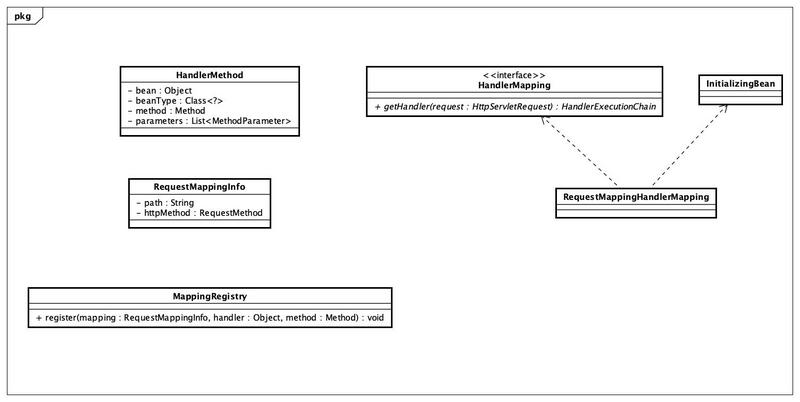不知道大家有没有好奇过,SpringMVC是如何通过request就可以找到我们写的Controller中的一个方法,它是怎么做到的,什时候做的呢? 本节我们就来开发HandlerMapping的初始化过程,把Controller中的方法转换成我们定义的HandlerMethod对象(也就是架构图中画的Handler),根据注解RequestMapping来映射url和HandlerMethod的对应关系。首先我们先来看下本节中涉及到的类
4.1 研发步骤讲解
本节所有的代码都放在分支:handlerMapping-initial
HandlerMapping接口
HandlerMapping接口中只有一个方法,通过request找个需要执行的handler,包装成HandlerExecutionChain,改方法本节中暂时不实现,下一节再来开发这部分代码,今天主要是实现HandlerMapping的初始化过程
public interface HandlerMapping {
HandlerExecutionChain getHandler(HttpServletRequest request) throws Exception;
}RequestMapping注解
RequestMapping注解,只提供了两个属性path,method
path表示url中的路径method表示http请求的方式GET,POST
@Target({ElementType.TYPE, ElementType.METHOD})
@Retention(RetentionPolicy.RUNTIME)
@Documented
public @interface RequestMapping {
String path();
RequestMethod method() default RequestMethod.GET;
}RequestMappingInfo
主要是对应配置在控制器方法上的RequestMapping注解,把RequestMapping注解转换成RequestMappingInfo对象
public class RequestMappingInfo {
private String path;
private RequestMethod httpMethod;
public RequestMappingInfo(String prefix, RequestMapping requestMapping) {
this.path = prefix + requestMapping.path();
this.httpMethod = requestMapping.method();
}
public String getPath() {
return path;
}
public RequestMethod getHttpMethod() {
return httpMethod;
}
}HandlerMethod
HandlerMethod是个很重要的对象,主要是对应控制器中的方法,也就是实际处理业务的handler;这里我们暂时定义了三个属性
- bean: 表示该方法的实例对象,也就是Controller的实例对象
- beanType: 表示的是我们写的Controller的类型;比如我们常定义的:
IndexController、UserController等等 - method: 表示Controller中的方法
- parameters: 表示方法中的所有参数的定义,这里引用了Spring中提供的
MethodParameter工具类,里面封装了一些实用的方法,比如说后面会用到获取方法上的注解等等
本节HandlerMethod只提供了一个构造方法,通bean和method构建一个HandlerMethod对象
public class HandlerMethod {
private Object bean;
private Class<?> beanType;
private Method method;
private List<MethodParameter> parameters;
public HandlerMethod(Object bean, Method method) {
this.bean = bean;
this.beanType = bean.getClass();
this.method = method;
this.parameters = new ArrayList<>();
int parameterCount = method.getParameterCount();
for (int index = 0; index < parameterCount; index++) {
parameters.add(new MethodParameter(method, index));
}
}
}MappingRegistry
MappingRegistry是RequestMappingInfo、HandlerMethod的注册中心,当解析完一个控制器的method后就会向MappingRegistry中注册一个;最后当接收到用户请求后,根据请求的url在MappingRegistry找到对应的HandlerMethod;本节写了三个方法:
- register: 把解析完成的
RequestMappingInfo注册到Map中;通过method,handler构建HandlerMethod对象,然后也加入到Map中 - getMappingByPath: 通过path查找出
RequestMappingInfo - getHandlerMethodByPath: 通过path查找出
HandlerMethod
/**
* 所有映射的注册中心
*/
public class MappingRegistry {
private Map<String, RequestMappingInfo> pathMappingInfo = new ConcurrentHashMap<>();
private Map<String, HandlerMethod> pathHandlerMethod = new ConcurrentHashMap<>();
/**
* 注册url和Mapping/HandlerMethod的对应关系
*
* @param mapping
* @param handler
* @param method
*/
public void register(RequestMappingInfo mapping, Object handler, Method method) {
pathMappingInfo.put(mapping.getPath(), mapping);
HandlerMethod handlerMethod = new HandlerMethod(handler, method);
pathHandlerMethod.put(mapping.getPath(), handlerMethod);
}
public RequestMappingInfo getMappingByPath(String path) {
return this.pathMappingInfo.get(path);
}
public HandlerMethod getHandlerMethodByPath(String path) {
return this.pathHandlerMethod.get(path);
}
}RequestMappingHandlerMapping
本节需要使用的组件类都已经写完了,现在就开始开发主要类RequestMappingHandlerMapping的初始化过程,完整代码如下:
public class RequestMappingHandlerMapping extends ApplicationObjectSupport implements HandlerMapping, InitializingBean {
private MappingRegistry mappingRegistry = new MappingRegistry();
public MappingRegistry getMappingRegistry() {
return mappingRegistry;
}
public void afterPropertiesSet() throws Exception {
initialHandlerMethods();
}
private void initialHandlerMethods() {
Map<String, Object> beansOfMap = BeanFactoryUtils.beansOfTypeIncludingAncestors(obtainApplicationContext(), Object.class);
beansOfMap.entrySet().stream()
.filter(entry -> this.isHandler(entry.getValue()))
.forEach(entry -> this.detectHandlerMethods(entry.getKey(), entry.getValue()));
}
/**
* 类上有标记Controller的注解就是我们需要找的handler
*
* @param handler
* @return
*/
private boolean isHandler(Object handler) {
Class<?> beanType = handler.getClass();
return (AnnotatedElementUtils.hasAnnotation(beanType, Controller.class));
}
/**
* 解析出handler中 所有被RequestMapping注解的方法
*
* @param beanName
* @param handler
*/
private void detectHandlerMethods(String beanName, Object handler) {
Class<?> beanType = handler.getClass();
Map<Method, RequestMappingInfo> methodsOfMap = MethodIntrospector.selectMethods(beanType,
(MethodIntrospector.MetadataLookup<RequestMappingInfo>) method -> getMappingForMethod(method, beanType));
methodsOfMap.forEach((method, requestMappingInfo) -> this.mappingRegistry.register(requestMappingInfo, handler, method));
}
/**
* 查找method上面是否有RequestMapping,有 => 构建RequestMappingInfo
*
* @param method
* @param beanType
* @return
*/
private RequestMappingInfo getMappingForMethod(Method method, Class<?> beanType) {
RequestMapping requestMapping = AnnotatedElementUtils.findMergedAnnotation(method, RequestMapping.class);
if (Objects.isNull(requestMapping)) {
return null;
}
String prefix = getPathPrefix(beanType);
return new RequestMappingInfo(prefix, requestMapping);
}
private String getPathPrefix(Class<?> beanType) {
RequestMapping requestMapping = AnnotatedElementUtils.findMergedAnnotation(beanType, RequestMapping.class);
if (Objects.isNull(requestMapping)) {
return "";
}
return requestMapping.path();
}
@Override
public HandlerExecutionChain getHandler(HttpServletRequest request) throws Exception {
return null;
}
}因为在初始化的过程中,我们需要获取到容器中所有的Bean对象,所以RequestMappingHandlerMapping需要继承于ApplicationObjectSupport,ApplicationObjectSupport为我们提供了方便访问容器的方法;因为RequestMappingHandlerMapping需要在创建完对象后初始化HandlerMethod,所以实现了接口InitializingBean(提供了afterPropertiesSet方法,在对象创建完成后,spring容器会调用这个方法),初始化代码的入口就在afterPropertiesSet中。
private void initialHandlerMethods() {
Map<String, Object> beansOfMap = BeanFactoryUtils.beansOfTypeIncludingAncestors(obtainApplicationContext(), Object.class);
beansOfMap.entrySet().stream()
.filter(entry -> this.isHandler(entry.getValue()))
.forEach(entry -> this.detectHandlerMethods(entry.getKey(), entry.getValue()));
}首先我们需要从容器中拿出所有的Bean,这里我们用的是Spring提供的工具类BeanFactoryUtils.beansOfTypeIncludingAncestors(obtainApplicationContext(), Object.class);,该方法将会返回beanName和bean实例对应的Map;
接着需要过滤出所有被标记@Controller的类,代码写在了isHandler方法中
/**
* 类上有标记Controller的注解就是我们需要找的handler
*
* @param handler
* @return
*/
private boolean isHandler(Object handler) {
Class<?> beanType = handler.getClass();
return (AnnotatedElementUtils.hasAnnotation(beanType, Controller.class));
}这里也使用到了Spring中的工具类AnnotatedElementUtils.hasAnnotation判断类是否有添加注解@Controller; 找出所有的Controller之后,我们需要解析出Controller中的所有方法,构建我们需要的HandlerMethod
/**
* 解析出handler中 所有被RequestMapping注解的方法
*
* @param beanName
* @param handler
*/
private void detectHandlerMethods(String beanName, Object handler) {
Class<?> beanType = handler.getClass();
Map<Method, RequestMappingInfo> methodsOfMap = MethodIntrospector.selectMethods(beanType,
(MethodIntrospector.MetadataLookup<RequestMappingInfo>) method ->
getMappingForMethod(method, beanType));
methodsOfMap.forEach((method, requestMappingInfo) -> this.mappingRegistry.register(requestMappingInfo, handler, method));
}
/**
* 查找method上面是否有RequestMapping,有 => 构建RequestMappingInfo
*
* @param method
* @param beanType
* @return
*/
private RequestMappingInfo getMappingForMethod(Method method, Class<?> beanType) {
RequestMapping requestMapping = AnnotatedElementUtils.findMergedAnnotation(method, RequestMapping.class);
if (Objects.isNull(requestMapping)) {
return null;
}
String prefix = getPathPrefix(beanType);
return new RequestMappingInfo(prefix, requestMapping);
}使用工具类MethodIntrospector.selectMethods找出Controller类中所有的方法,遍历每个方法,判断方法是否有添加注解@RequestMapping,如果没有就返回空,如果有就通过@RequestMapping构建RequestMappingInfo对象返回;如果所Controller类上有添加注解@RequestMapping,那么配的path将作为前缀
private String getPathPrefix(Class<?> beanType) {
RequestMapping requestMapping = AnnotatedElementUtils.findMergedAnnotation(beanType, RequestMapping.class);
if (Objects.isNull(requestMapping)) {
return "";
}
return requestMapping.path();
}当所有的方法都解析完成之后,需要把所有配置有@RequestMapping注解的方法注册到MappingRegistry,代码如下: methodsOfMap.forEach((method, requestMappingInfo) -> this.mappingRegistry.register(requestMappingInfo, handler, method));
4.3 单元测试
到此为止,我们把Controller中方法的解析过程已经开发完成,接下来我们来写一点简单的单元测试。
AppConfig.java中添加代码构建RequestMappingHandlerMapping
@Configuration
@ComponentScan(basePackages = "com.silently9527.smartmvc")
public class AppConfig {
@Bean
public RequestMappingHandlerMapping handlerMapping() {
return new RequestMappingHandlerMapping();
}
}为了测试我们的Controller解析是否正确,我们需要的测试用例:
- 在IndexController中我们在类上面配置path的前缀
/index;解析完成后的path要拼接上/index - 在IndexController中添加三个方法,其中
test、test2两个用@RequestMapping标注,test3不标注;解析完成后test3不再我们注册中心里面,test、test2两个在注册中里面,并且@RequestMapping中的属性正确解析成RequestMappingInfo对象 - 创建TestConroller类,添加一个方法
test4,在类上面标注注解@Service,解析完成后test4不能在注册中心里面找到
IndexController,TestController代码如下:
@Controller
@RequestMapping(path = "/index")
public class IndexController {
@RequestMapping(path = "/test", method = RequestMethod.GET)
public void test(String name) {
}
@RequestMapping(path = "/test2", method = RequestMethod.POST)
public void test2(String name2) {
}
public void test3(String name3) {
}
}@Service
public class TestController {
@RequestMapping(path = "/test4", method = RequestMethod.POST)
public void test4(String name2) {
}
}接下来建立我们的单元测试类RequestMappingHandlerMappingTest,继承于我们上一节写好的测试基类BaseJunit4Test
public class RequestMappingHandlerMappingTest extends BaseJunit4Test {
@Autowired
private RequestMappingHandlerMapping requestMappingHandlerMapping;
@Test
public void test() {
MappingRegistry mappingRegistry = requestMappingHandlerMapping.getMappingRegistry();
String path = "/index/test";
String path1 = "/index/test2";
String path4 = "/test4";
Assert.assertEquals(mappingRegistry.getPathHandlerMethod().size(), 2);
HandlerMethod handlerMethod = mappingRegistry.getHandlerMethodByPath(path);
HandlerMethod handlerMethod2 = mappingRegistry.getHandlerMethodByPath(path1);
HandlerMethod handlerMethod4 = mappingRegistry.getHandlerMethodByPath(path4);
Assert.assertNull(handlerMethod4);
Assert.assertNotNull(handlerMethod);
Assert.assertNotNull(handlerMethod2);
RequestMappingInfo mapping = mappingRegistry.getMappingByPath(path);
RequestMappingInfo mapping2 = mappingRegistry.getMappingByPath(path1);
Assert.assertNotNull(mapping);
Assert.assertNotNull(mapping2);
Assert.assertEquals(mapping.getHttpMethod(), RequestMethod.GET);
Assert.assertEquals(mapping2.getHttpMethod(), RequestMethod.POST);
}
}单元测试运行结果正常通过:
4.4 本节小结
本节我们实现了HandlerMapping的初始化,了解到了Controller中的方法是如何转换成HandlerMethod; 如果有面试官问SpringMVC的原理是什么,我想大家肯定能说出来;如果面试官继续追问@RequsetMapping标注的方法转换成Handler的过程是怎样的?学完了本节我想大家也能回答了
4.5 延展
本节我们实现的RequestMappingHandlerMapping,HandlerMethod相比SpringMVC都比较简单,大家可以对应着去看看SpringMVC中的实现;因为在SpringMVC中不仅仅有@RequestMapping,还有基于xml配置的SimpleUrlHandlerMapping以及BeanNameUrlHandlerMapping等等,所有RequestMappingHandlerMapping在SpringMVC中还有两层抽象类,有兴趣的小伙伴可以去看看每个实现。

